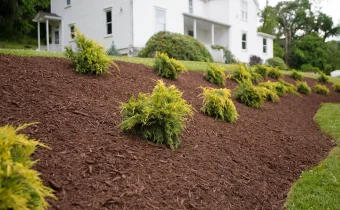Brown spots. Disease patches. Bare areas.
Nobody likes to see this in their lawn. But, why does it seem to happen every summer in Pittsburgh? And how can you tell the difference between a lawn that is dormant versus a lawn that is dead?
First it’s helpful to take a look at the type of grasses that are popular here in Northern Pennsylvania – Kentucky Bluegrass and Tall Fescue. Both of these grasses are what we call “cool-season grasses”.
What are Cool Season Grasses?
Cool season grasses are varieties of grass that do well in geographical areas that have cold winters and hot summers.
Sound familiar? In Pittsburgh, our winters drop to the low 20’s and our summers get into the high 90’s.
Lawn care companies choose cool season grasses for our area because of their higher tolerance to sun, their resistance to pests and diseases and their adaptability to foot traffic.
You can identify which type of grass you have here.
Types of Summer Stress in Lawns
In the summer, even the best grass types can get stressed when temperatures are above 80 degrees consistently and the weather is humid.
Please be alert to these summer lawn conditions.
Dry and compacted soil
A simple way to tell how your soil is doing is to pull a soil plug and analyze it. If the soil sample cracks or blows away in the wind, it’s a surefire way to tell that you need to water more.
Hot hard surfaces nearby
In the summer, black asphalt can get so hot you could probably cook an egg on it! Turf that surrounds pavement, rocks, concrete or other hard surfaces causes the roots to burn and grass suffers. In these areas you may see strong weeds like crabgrass invade.
A combination of high heat and humidity
When heat combines with humidity, you have a petri dish of bacteria just waiting to multiply. Fungus, also called disease, then becomes prevalent causing brown circular spots in your lawn.
Unnecessary human impact
Heavy foot traffic doesn’t help this equation. Also, mowing with a dull blade will tear the grass blades, making an open wound that is susceptible to pests and disease. For best results sharpen your blades 2-3 times per growing season. We sharpen ours daily.
Insects actively feeding
Chinch bugs, sod webworms and grubs could be the culprits for stressed lawns. These pests suck moisture from already dry grass blades causing lawns to die.
Dormancy Versus Dead Lawns
As you can tell, all of this summer pressure gives our cool-season grasses a hard time to stay alive.
So how can you tell if your brown lawn is dead or dormant?
Lawn Dormancy
Most of the time non-irrigated lawns turn dormant in late July after about two to three weeks with no water. They can remain brown and dormant, but alive, for approximately four to six weeks without water. (source)
Many times, a lawn can recover from dormancy.
Tips to Revive a Lawn from Dormancy
- If the lawn goes more than 4 weeks without substantial rainfall, provide supplemental water. Wet the soil to a depth of 5 inches every week there after.
- Keep your lawn mower blade sharp and mow high. If it’s not raining, it’s not growing and you shouldn’t be mowing. If you do mow, make sure your blades are sharp and mow during the coolest time of the day (morning or evening).
- Stop fertilizing and leave the lawn alone. Try to stay off the lawn (including vehicles and the dog) as that will only provide more stress to the crunchy, brown grass blades. Never fertilize a dormant lawn as it will promote unnecessary growth during a time when it is hibernating.
These tips may not help your lawn magically turn green again, but it will benefit the roots and structure of the grass blades so when fall and cooler temperatures return, you won’t have a dead lawn.
Speaking of dead lawns…
Dead Lawns
Lawn damage that is irreparable will cause the grass blades to die. The critical difference here is that if a lawn is dead, it cannot be revived.
Determining if a patch of grass is dead or just dormant can be difficult. A
close examination is required. Dormant grass will be firm at the base and
resist a gentle tug. Dead grass will be shriveled with dead roots. It can be
uprooted easily and will have dead, non-functioning roots. (source)
How to Re-Establish Dormant Recovering and Damaged Lawns
No matter what the cause and no matter what the result, ALMOST ALWAYS a solution is to aerate and overseed your lawn in the fall. This is a tried and true practice that can only help a lawn and will never damage it.
Lawn Aeration
Think of this as allowing your lawn to breathe again, after holding its breath all summer.
Core aeration is the process of taking small plugs out of densely compacted soil—i.e. your lawn after a long summer of heat. The plugs are then deposited on the surface.
The best time to perform core aeration is the fall. Whether you choose to go ahead and perform core aeration in August and not have to worry about it when it gets colder, or if you would like to wait until the grass has started to slow down in October before wintertime, both are acceptable.
Lawn Overseeding
After your lawn takes a breath, it’s time to give it some help.
By adding more grass seed, you can fill in bare areas and give the lawn a boost that it needs to come back thicker and stronger than ever next spring

Did you know that Dream Greener also offers Compost Top-Dressing? This service aids in both the growth of the new seed and adds important organic matter to your clay soil.
Help your cool-season lawn recover this fall with aeration and overseeding done by the professionals at Dream Greener.
Request a free lawn analysis today!





